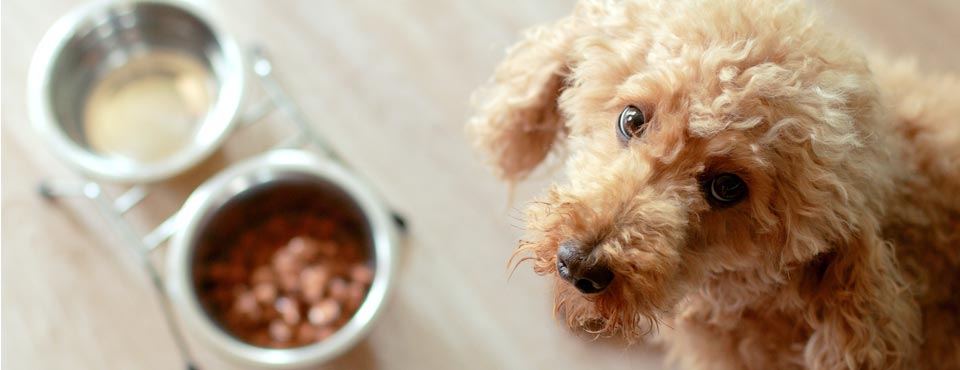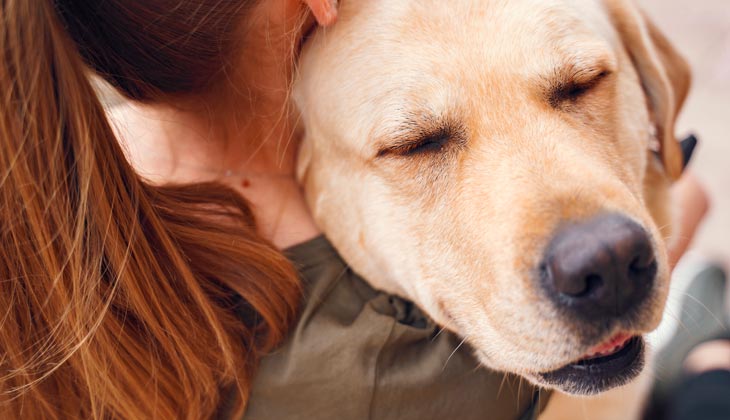
Is My Dog Overweight?
CARE & NUTRITION
15 Jan, 2022
6 minutes
DID YOU KNOW THAT MORE THAN HALF OF ALL DOMESTIC DOGS ARE OVERWEIGHT?
Obesity is one of the most common issues veterinarians see in their practices, and while a few extra pounds on your pooch may seem harmless (and not always obvious either), the extra weight can actually predispose your four-legged friend to a variety of health issues as well as a shorter lifespan.
There are many factors that can lead to excess weight gain. Some of these causes, such as breed and age, are out of our control but we can control diet, which is a key reason for canine weight gain. You may love to give your pup treats throughout the day or slip him or her scraps from the table, thinking “what’s the harm?” But in fact, those extra nibbles really add up.
HOW TO IDENTIFY AN OVERWEIGHT DOG
One of the simplest ways to determine if your dog is overweight is to use your own eyes and hands. Here are some key factors you can assess:
BODY SHAPE.
Stand above your dog and look down, with a bird’s eye view. Ideally, his or her body will be hourglass shaped, tucking in slightly behind the ribs. If your pooch is more round or oval shaped, he or she is likely overweight.

RIBS & SPINE.
Here’s where you can use your hands, feeling along your dog’s ribcage. If your pet is a healthy weight, you should be able to feel his or her ribs under the coat and skin. You can do the same along the spine to ensure the bones are not standing out, as this is a sign your dog could be underweight.
SIDE VIEW.
Looking at your dog’s profile, you can also determine if he or she is overweight. Is the waist sagging? Does the tummy swing? These attributes could be telling you that your pup is overweight. Ideally, the bottom profile of the abdomen should be higher than the ribcage, rather than even with it and the abdomen should definitely not hang below.
FAT PADS
Some dogs will have deposits of fat, or fat pads between their legs and on the tops of their hips. You can inspect for these while petting your pooch. These little pockets of fat are a major indicator of being overweight.
BEHAVIOR
If you notice that your dog would rather scarf down his or her kibble than run to catch a ball, this could be consistent with a weight problem. Overweight dogs are typically less active, may have trouble walking and sometimes have trouble breathing during physical exertion. These are signs to be on the lookout for in evaluating your tubby puppy.

YOUR OVERWEIGHT DOG NEEDS YOUR HELP
Just as being overweight is not healthy for people, there is a long list of health issues that can impact your furry companion as well. These include:
- Trouble breathing
- Joint problems such as arthritis
- Diabetes
- Heart problems
- Kidney disease
- High blood pressure
- Certain cancers
- Mobility issues
- Immune system problems
- Reduced lifespan
Negative food-related behaviors can also emerge as a result of weight problems. Guarding and stealing food, as well as begging, are behaviors that are sometimes associated with canine obesity.
WEIGHING IN
Helping your dog starts with a visit to your veterinarian who will be able to tell you if your dog is overweight. Your veterinarian is likely to compare his or her body to a “body condition score chart,” which ranks a dog’s body type and shape. Scores generally range from 1 to 9, from extremely underweight to obese. The target body condition is usually around 4 or 5. Keep in mind that a healthy weight will look different for every breed. Some breeds are naturally lean, such as greyhounds or whippets, whereas others, like Labradors and retrievers, are predisposed to weight gain.

Your dog’s age will also be significant. Puppies need more calories than older pups, but sometimes we forget to reduce our pups’ food intake once they reach adulthood, and extra pounds can start building up as calorie intake exceeds energy expended.
Senior dogs are also likely to gain weight as their metabolism starts to slow down. It’s important to reduce calorie intake accordingly.
DEVELOP A PLAN
If your veterinarian determines that your dog is overweight, you will need to start a weight-loss plan that targets reducing calories and increasing exercise. Your veterinarian can help you establish a workable plan.
EXERCISE

Getting your dog out for walks is the best way to get him or her moving. Don’t overdo it at first. yYou can start with 10 to 15 minute walks daily and gradually increase the time and briskness of the walks. Some experts recommend walking your dog for up to 2 hours every day, depending on your dog’s age and breed. It’s important to praise your dog and reward him or her with lots of attention. This makes the walks fun and makes him or her eager to go out and walk again.
DIET
Your veterinarian can help you develop a weight loss diet plan that reduces calories and portions while ensuring your dog still gets the nutrition he or she needs. “Free feeding” (making food available to your dog at all times) is usually not the best option for your pup and remember to keep treats to a minimum.
Implementing simple diet and lifestyle changes will help to get your beloved furry friend’s weight under control and reduce the risks around the variety of health issues he or she could be facing otherwise. It’s not too late!
RECOMMENDED
POPULAR PAGES





